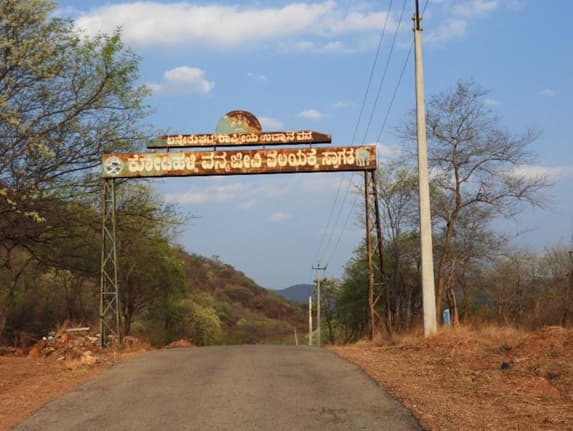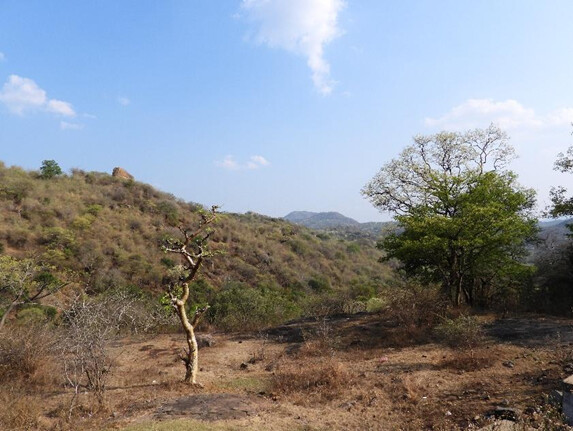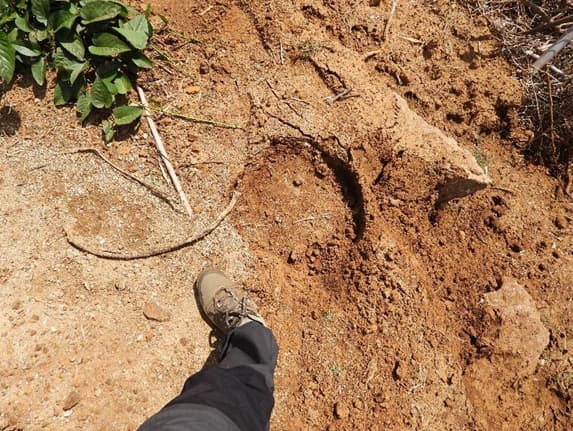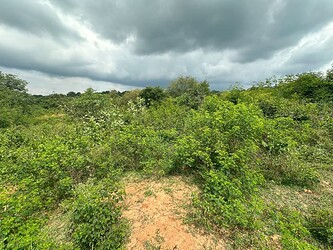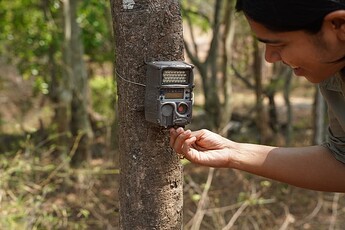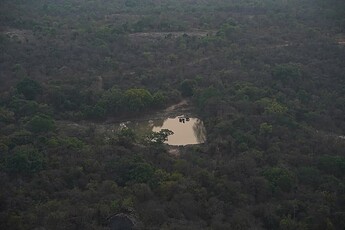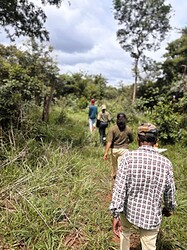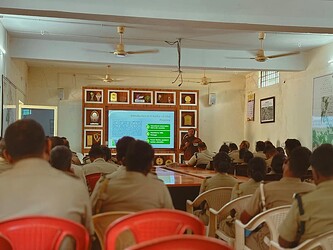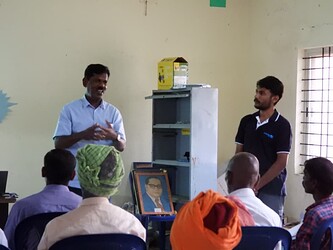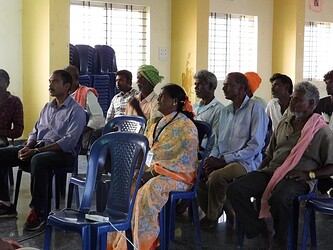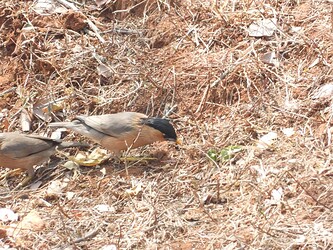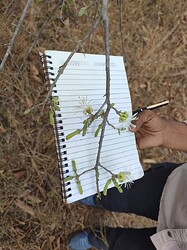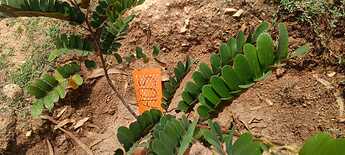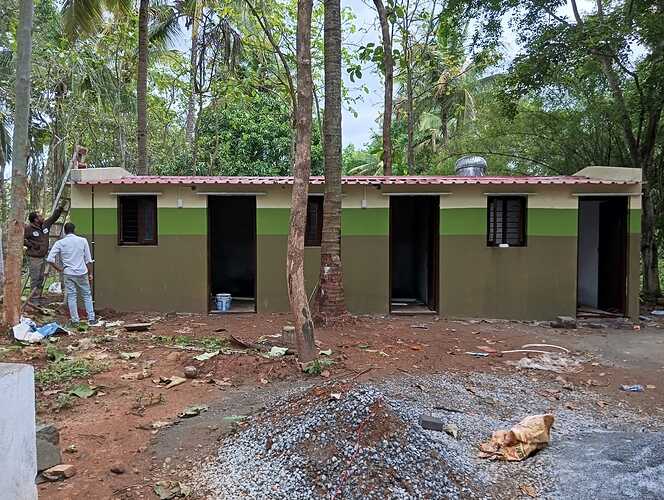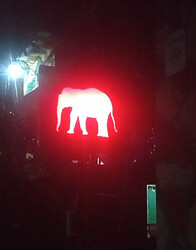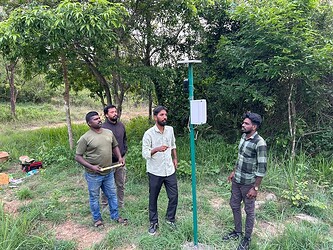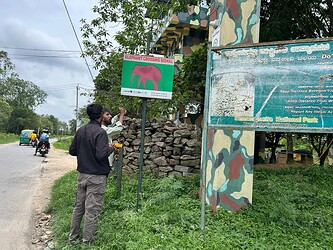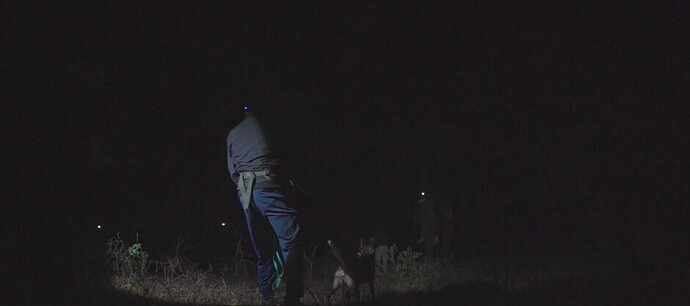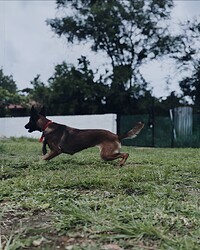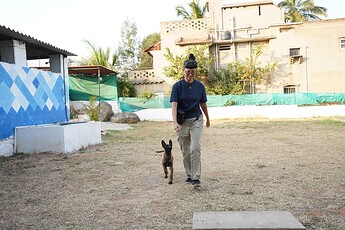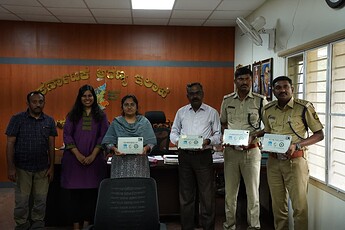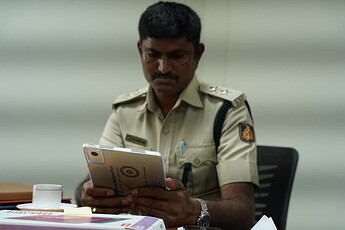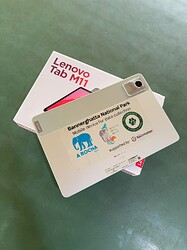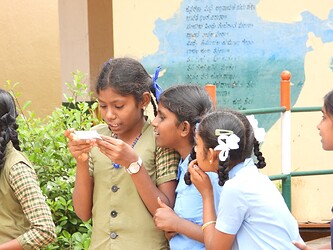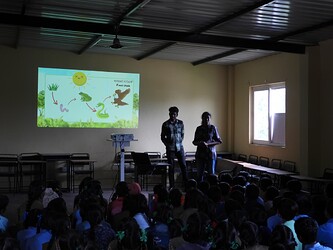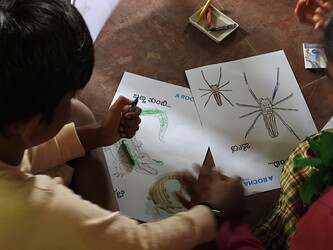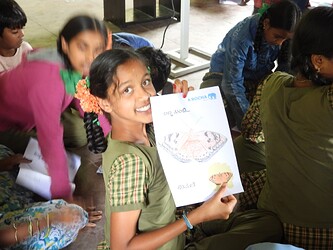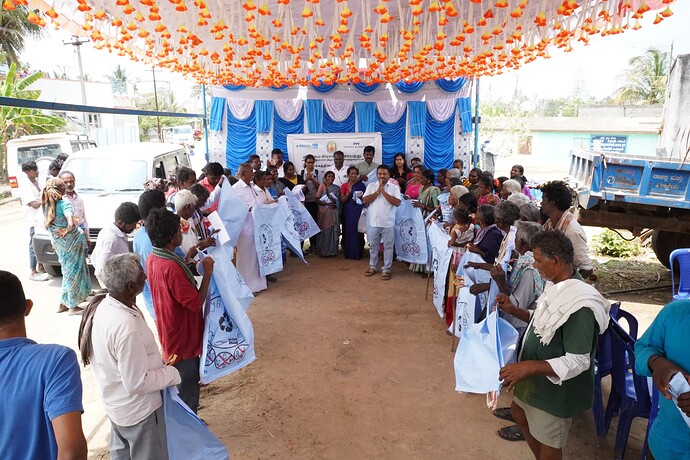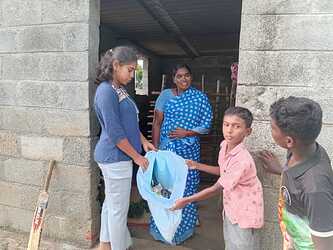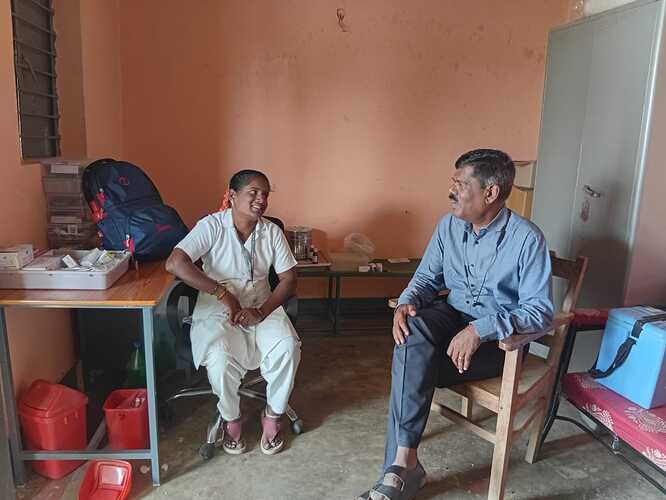SIX MONTH UPDATE!
Following is an overview of the work update for A Rocha India for the months of July to December 2024. We have systematically organized our work in 4 zones (as previously introduced) which encompass 15 different projects that are at various stages of their life cycles currently. The past six months, we have focused on working within the Bannerghatta – Hosur Landscape (BHL)
These zones include: Forests, buffer areas, croplands and urban areas.
In the last six months our efforts have been mobilized via a network of people, organizations, institutions and government agencies over and above our own staff’s hard work and dedication, to push for a landscape level conservation model in the BHL. We have partnered with over 15 collaborators, reached out to over 6000 people via various programs, workshops and media channels with our message, and conducted over 20 programs including workshops, capacity building training sessions, sensitization programs and others. We have also inducted 125 volunteers from various walks of life including working professionals, students, scientists, farmers and city folk, giving them an opportunity to contribute towards conservation efforts. We have also hosted 5 interns from Bangalore and other parts of the world, who have been able to add expertise to our work and gain valuable experience and knowledge while doing so.
The overall outcome that we have seen so far include
- Building a working relationship with the local communities that we hope to work with and establishing a welcome presence in their villages and towns
- Establishing a network of passionate, enthusiastic and skilled volunteers, interns and consultants who have contributed to our work and continue to be associate with us in various capacities. This has allowed us to mainstream conservation in a big way.
- Fostering partnerships and collaborations with multiple stakeholders, organizations, educational institutions and government agencies.
- Framing problem statements using science and research tools to understand the major conservation issues of our landscape.
- Setting up, standardizing, and refining methods for research and monitoring that are SMART, cost & time-effective for the local context of our work.
- Innovating solutions to mitigate conservation needs in high priority areas.
Read on for a more detailed, project wise update.
1. RESTORING WILDLIFE CORRIDORS:
Over the past six months, significant progress has been made in enhancing wildlife corridor initiatives.
- Defined Parameters : Through relevant review of literature, we have established specific parameters that are currently used for identifying wildlife corridors. Building upon this, we have been able address some of the gaps that exist in corridor assessments and are confident that the defined parameters will inform our monitoring strategies for effective surveys.
- Proposed Guidelines: Comprehensive guidelines are being proposed for identifying additional wildlife corridors within the BHL region., ensuring a systematic approach. Assessing conflict patterns, sign surveys and including local people’s perspectives are key elements that have contributed to the guidelines we are building.
- Information Gathering : We have actively gathered data on wildlife movement, biotic pressures, and potential threats to these corridors, providing a robust and informed foundation for our conservation efforts.
Our team has conducted surveys in the identified potential corridors which traverse across the Karnataka and Tamil Nadu state border to assess the current status of these areas. We have also provided opportunity of 3 volunteers from undergraduate science backgrounds to aid in data collection and learn the various methods employed for these assessments.


2. ERADICATION OF INVASIVE ALIEN SPECIES
In the last six months we have conducted the following important steps towards the eradication of invasive alien species:
- Identification of Affected Regions : Thorough assessments were conducted in close association with the forest department to identify areas severely impacted by IAS.
- Standardization of Removal Methods : In collaboration with our partners like the Sholas Trust, the Lantana collective and others, we have access to standardized methods for the removal of IAS.
An identified 20ha of plots ready for removal in the southern beat of Jawalgiri, Tamil Nadu. The area is heavily infested with Lantana Camara, along with other invasive species like Eupatorium sp. and Parthenium sp. interspersed with native flora like Bamboo and Gooseberry. The site’s ecological importance has been underscored signs of wildlife, including elephant dung and tracks of Indian gaur and spotted deer near a watering hole. To advance the project, we will be assessing vegetation and wildlife occupancy, setting up camera traps and further collaborating with The Shola Trust to develop a comprehensive action plan for the eradication and monitoring post removal. Community involvement will play a pivotal role in the eradication and monitoring phases of the project. Local community members will actively participate in physically removing Lantana camara, contributing their labour and local knowledge to the effort. To incentivize their engagement, provisions will be made to offer fair compensation for their work in uprooting and clearing the invasive species. Additionally, locals will be involved in the post-removal monitoring of the plots, where they will assist in tracking regrowth, ensuring proper maintenance and recording ecological changes over time. These efforts will provide a source of income and foster a sense of ownership and stewardship among the community, strengthening their role as active partners in the long-term conservation and restoration of the landscape.
 ,
,

3. SYNTHESIS OF ECOLOGICAL INFORMATION THROUGH WILDLIFE MONITORING
In the past six months, significant research activities have been undertaken to enhance our understanding of wildlife distribution and management strategies through monitoring wildlife – specifically terrestrial mammals – in the Bannerghatta National Park and North Cauvery Wildlife Sanctuary.
- In BNP, we conducted a detailed assessment of terrestrial mammal composition, comparing our findings with existing data to evaluate changes over time. Primarily employing the use of camera trap technology, we have analysed data to:
- Identify bull elephants within Bannerghatta National Park and Hosur forest division. This information is crucial to mitigating conflict caused in this region and has come in handy for management on two occasions during our study period to identify conflict-prone individuals (bull elephants).
- Additionally, we assessed habitat use among co-predators, providing insights into their interactions and ecological roles within the park.
- And most notably, we have recorded the first discovery of otters (Smooth Coated Otter) in BNP, confirming their habitat preferences and contributing to our understanding of this dynamic habitat.
- Study Design for understanding elephant distribution in the Krishnagiri-Kolar-Chittor landscape: The study focuses on comprehensively understanding the distribution of elephants across the Krishnagiri-Kolar Chittor region. This involved mapping areas of human-elephant conflict and analysing public perception through a spatio-temporal lens to identify hotspots of conflict and distribution, which will aid in developing targeted mitigation strategies to promote coexistence between elephants and local communities.
- Understanding space use patterns of disbursing elephants in Ramnagara forest division. Our team worked collaboratively with the forest department on an important driving operation to manage the disbursement of 24 male elephants. This allowed us the opportunity to gather data on the space use patterns and habitat preference of these individuals.
- Methodology Development for Monitoring Connectivity Structures: Lastly, we have successfully monitored the newly erected wildlife overpass, which is the first of its kind in Asia in Kaggalipura, Bangaluru. The monitoring specifically focusing on the effectiveness of the wildlife overpasses. Our report includes an evaluation of these man-made connectivity features, assessing their impact on wildlife movement patterns and safety. Based on our findings, we will make management recommendations aimed at enhancing the efficacy and relevance of such structures in facilitating safe wildlife crossings.
 ,
,

 ,
,

 ,
,

4. TACKLING ILLEGAL WILDLIFE TRADE
In the last six months, we have undertaken several critical initiatives aimed at combating wildlife crime in the region and fostering community engagement in conservation efforts.
a. Gain insights into wildlife crime in the region and gather information on offenders: Working carefully through a network of informants, we have been able to establish a trusted chain of local intel that feeds back into the Karnataka and Tamil Nadu forest departments of Bannerghatta and Hosur. This network has given us insight into the nature of wildlife trade and crime in the region, along with vital information on species and related contraband that are most commonly traded. We have been able to successfully aid the management system in apprehending criminals and even identifying supply chains within the region.
b. Building a robust community including locals to prevent wildlife trade and illegal poaching: Recognizing the importance of community involvement, we focused on building a robust network that includes local residents to prevent wildlife trade and illegal poaching. By fostering relationships with community members, we aim to create a sense of ownership and responsibility towards wildlife conservation, encouraging locals to report suspicious activities. In the last 6 months, A Rocha has also expanded its activities to Shikarimedu village, where the team conducts hygiene surveys to maintain public presence and foster community engagement.
c. Capacity building: To build capacity among enforcement officials, A Rocha India, in partnership with the Karnataka and Tamil Nadu Forest Departments, organised two workshops that focused on updating knowledge and case filing procedures for the department staff. The session focused on the legal frameworks and procedures involved in combating illegal wildlife trade. Forest guards, rangers, and Deputy Range Forest Officers (DRFOs) actively participated, with 60 officials discussing the challenges and strategies for tackling wildlife crimes. As part of the initiative, copies of “Wildlife Laws for Rangers” (including the 2022 amendments) were distributed to all participants. The workshop proved to be highly informative and productive, fostering a deeper understanding of the complexities of wildlife crime enforcement. It also strengthened collaboration between A Rocha India and the Forest Department, paving the way for more coordinated and impactful conservation efforts.
d. Building awareness regarding poaching and illegal wildlife trade among students and city folk in order to make them vigilant about wildlife-related crimes: To further combat poaching and illegal wildlife trade, we launched awareness campaigns targeting students and urban populations. These initiatives aim to educate individuals about the impacts of wildlife crime and encourage vigilance against such activities. We conducted 2 sensitization programs, 1 in Karnataka and 1 in Tamil Nadu for interested volunteers, villagers and students, explaining the legal, local and cultural complexities of illegal wildlife trade in India, including pet trade rings that are directly linked to biodiversity loss.
e. Removal of snares: Finally, we undertook the removal of snares from protected areas (PAs) and conducted workshops to raise awareness about various trapping devices used for wildlife capture. Educating the public about these devices is crucial for preventing snaring incidents and protecting vulnerable wildlife species. To ensure that this is an awareness exercise, we involve volunteers along with locals and forest department staff to conduct these anti-snare drives.
5. PRIMARY RESPONSE TEAM
In the last 6 months, the Primary Response Team (PRT) project has made significant progress. The Primary Response Team (PRT) serves as the first responder group for analyzing and aiding mitigation of Human-Elephant Conflict (HEC), working closely with the forest department and local communities. This is a proactive measure to HEC mitigation, where the PRT conducts vigilance surveys in the forest – farm interface to report on and respond to active HEC instances. The following objectives have been achieved so far:
- Volunteer induction: The PRT is a collaborative effort and the team must consist of at least one volunteer along with NGO staff, village personnel and forest department personnel. We have selected and oriented over 30 volunteers who have shown interest in participating in the PRT exercise. The intent is to equip volunteers to be informed resources during monitoring of HEC.
- Developing tech: An app for the PRT is under development with our tech partners ThinQuity. The app has been through several rounds of ground testing and will be available for a field demo soon. This will aid in ease of data collection while also providing a dynamic interface and dashboard to track live alerts.
- Collaborative co-learning and co-capacity building: with the target of reducing HEC levels, it is essential for us to learn about the patterns of elephant movement outside protected areas, patterns of conflict, its associated timelines and causal factors. This can only be done holistically when all the stakeholders are involved and work collaboratively to achieve a proactive mitigation measure. Liaising with the forest department and especially the Elephant Task Force (EFT) is a crucial step to achieving this. We touch base with the respective areas forest guards on a daily basis to get a sense of elephant movement and employ our efforts accordingly.
- Building an informant network within villages: Simultaneously we are also building a network of informants among villages within the Bannerghatta wildlife range. We have conducted sensitization programs in relevant villages to tell local communities about the PRT and also to show their farmers solidarity as they guard their crops at night. This incorporates us into their community in a way and builds trust.
- Patrolling and vigilance survey for proactive & cooperative measures for reducing crop-raiding in villages: The PRT has successfully conducted two months of night patrols in the Bannerghatta wildlife range. During these sessions, data is collected on elephant movement through direct sightings, indirect signs, and information from locals. Each survey involves an average of 80 km of road travel and lasts 4-7 hours. The team has also identified several villages where frequent elephant movement and crop raiding are major concerns.
6. FOREST FIRE MITIGATION
Forest fire mitigation efforts in Bannerghatta National Park (BNP) are critical due to its rich biodiversity, including endangered species like the Asian elephant, and the increasing risk of human-induced fires stemming from surrounding villages. Covering approximately 264 sq. km., BNP faces significant biotic pressures from 150 adjacent villages that rely on its ecosystems, heightening the threat of forest fires which can devastate wildlife, habitats, and water supplies. In the past six months we have done the following to understand the nature of forest fires in this region.
a. Mapping and Management Recommendations: To effectively manage fire risks, A Rocha India is collaborating with the Karnataka Forest Department and fire ecology professionals from NCBS to map vegetation in fire-prone areas and overlay this with existing fireline maps. This systematic approach aims to identify inconsistencies in fire line placements and enhance their effectiveness. The initiative includes conducting vegetation assessments and time series analyses to track fire degradation patterns over the past 15 years.
b. Data Auditing for Preventive Measures: Moreover, auditing data on fire management is essential for developing proactive strategies. A Rocha India emphasizes capacity building and community awareness among local forest officials and residents to foster sustainable practices that mitigate fire risks. These efforts are complemented by ongoing awareness programs. Through these integrated strategies, we aim to strengthen resilience against forest fires.
RESTORATION PROGRAMS
7. GRASSROOTS AFFORESTATION PROGRAM
A Rocha India has initiated a grassroots afforestation program aimed at restoring degraded landscapes near Bannerghatta National Park (BNP), focusing on systematic plantation drives and community engagement. Over the past six months, the program has developed a comprehensive afforestation plan to guide foresters in executing plantation activities effectively, ensuring greater success in these efforts. We are partnering with Mr. Sandilya Theurkauf of the Gurukula Botanical Sanctuary as one of the lead consultants on this project.
- Afforestation Planning and Native Species Utilization: The program emphasizes the importance of using native species for afforestation, which is critical for maintaining ecological balance. We are currently setting up nurseries and engaging with local forest departments for permits to collaboratively conduct growth rate experiments to create a comprehensive list of suitable native species, ensuring that the selected plants are well-adapted to the local environment. This approach not only promotes biodiversity but also enhances the resilience of newly established forests against pests and diseases.
- Restoration activity: In September a restoration drive was organized with the help of Christ University students and under the guidance of restoration expert Sandilya Theuerkauf, resulting in 200 saplings being planted across three acres in Anekal. This event not only contributed to reforestation efforts but also fostered community involvement and awareness about environmental conservation.
- Monitoring and Mitigation Strategies: To assess the success of the plantation efforts, A Rocha India has implemented a robust monitoring method that includes regular assessments of sapling health and growth. Six rounds of monitoring have already been conducted in collaboration with the Karnataka Forest Department. These assessments have identified challenges such as waterlogging in certain plots and minimal sapling mortality rates. In response, the team is exploring solutions like water drainage systems and soil adjustments to optimize growing conditions.
- Research and Biodiversity Restoration: Complementing these on-ground efforts, additional research activities, including microflora analysis conducted by A Rocha interns, have been integrated into the program. This research aims to enhance biodiversity restoration strategies and inform future plantation initiatives. By understanding biodiversity indicators, we can better tailor afforestation and restoration techniques in the future.
The grassroots afforestation program exemplifies a holistic approach to ecological restoration by combining scientific research, community engagement, and systematic planning. These efforts are vital for enhancing biodiversity while addressing environmental challenges posed by urbanization and habitat degradation. Through continued collaboration with local communities and forest officials, this initiative aims to create sustainable green spaces that benefit both wildlife and people in the region.
8. WATERBODY RESTORATION
Over the past six months, we have of a lake system within our campus adjacent to Bannerghatta National Park (BNP) in partnership with Ananas Permaculture. This initiative aims to promote biodiversity, replenish groundwater, enhance water quality, and provide recreational opportunities for the local community. The primary objectives of this waterbody restoration project are to increase groundwater availability and create a perennial water source for local biodiversity. And by adding to existing habitat, the project supports various species that rely on aquatic ecosystems for survival.
a. Functions of the Restored Pond: The pond serves multiple ecological functions. Its design encourages biodiversity by providing an ecosystem for aquatic and semi-aquatic species, which are currently underrepresented on A Rocha land. The excavation process has already attracted various fauna; during the digging and rock lining phases, numerous snakes were observed at the sedimentation pool, alongside butterflies engaging in mud puddling. Additionally, insects such as skippers and dragonflies, as well as amphibians like frogs, have been documented around the pond.
One significant benefit of the pond is its capacity for groundwater recharge. The region surrounding BNP faces dwindling groundwater resources, making this function increasingly vital. The pond can hold approximately 100 kiloliters (KL) of water, contributing to local aquifers and enhancing overall water availability. The pond also plays a crucial role in erosion control. Water runoff from nearby hills often leads to soil erosion; by providing a collection point for this water, the pond mitigates potential flooding and allows sediment to settle before it can wash away valuable topsoil.
b. Planting Native Species: to further enhance biodiversity around the pond, we have prioritized planting native species that thrive in the local ecoregion. This diverse planting strategy aims to support various faunal populations by creating a diversity of habitats.
9. EARLY WARNING SYSTEMS USING SIGNAL BOARDS
A Rocha India has implemented an innovative Early Warning System (EWS) using signal boards to mitigate human-elephant conflict along roads near Bannerghatta National Park (BNP). This initiative aims to reduce the risk of elephant-related road accidents while fostering coexistence between local communities and elephants. In the last six months, we have successfully achieved the following:
- Upgrading the Early Warning Systems technology: The EWS consists of strategically placed signal boards and sensors at known elephant crossing points, designed to alert motorists about potential elephant crossings. These boards are positioned at both the beginning and end of roads, providing timely warnings to drivers. The technology for these boards, initially developed by us in association with an IT university encountered challenges due to a GSM module that failed to transmit signals in certain areas. To enhance reliability, we are collaborating with Advantech to develop a new intranet-based system featuring a double infrared (IR) beam transmitter. This upgrade will improve accuracy, address the network issues previously faced with the GSM model and reduce false alarms triggers.
- Training and capacity building: To ensure the effectiveness of the EWS, we have conducted two FGD and training programs with the Karnataka and Tamil Nadu forest department staff (separately) to understand their concerns regarding the technology and to gather their feedback regarding the EWS. We have generally received positive and constructive feedback so far. Our team has conducted a recce survey in Hosur to assess the road networks where the EWD signal boards will be most effective.
- Monitoring and Maintenance: Regular monitoring is essential for maintaining the EWS’s functionality. In the past two months, A Rocha India has conducted 15 inspections to assess the condition of the signal boards and gather data on nearby elephant activity. While these boards are vital for preventing accidents, challenges persist, including damage from elephants and theft by locals. To address these issues, we have implemented a more rigorous inspection schedule to ensure that all equipment remains operational, we also employ our volunteer networks to monitor the signal boards regularly.
- Developing smart and innovative technologies: Tech tailored to local contexts is critical for effectively mitigating human-elephant conflict. The EWS not only serves as a preventive measure but also enhances understanding of elephant movement patterns, enabling better management strategies. By integrating technology with community engagement, we aim to create a sustainable coexistence framework that benefits both wildlife and local residents.
10. DEVELOPING ORGANIC FARMING PRACTICES
In the past six months we have in collaboration with Sahaj seeds organic launched an innovative project aimed at promoting organic farming practices among farmers in the village of Lakshmipura, Thally, as a sustainable alternative to chemical-intensive agriculture. This initiative focuses on creating a bank of disease and climate-resistant seeds and building knowledge through education and training for local farmers.
- Seed Bank Establishment: Central to this project is the establishment of a seed bank at the A Rocha Field Study Centre, which now houses 56 native seed varieties. This diverse stock is crucial for supporting farmers transitioning to organic methods, allowing them to engage in seed saving and maintain a reliable source of resilient crops. By providing access to these seeds, A Rocha India aims to empower local farmers, enabling them to cultivate crops that are better suited to withstand diseases and climate variability.
- Training and Capacity Building: To enhance farmers’ skills and knowledge in organic farming techniques, A Rocha India organized a two-day workshop. Led by Mr. Krishnaprasad from Sahaja Seed Organics and supported by experts like Mr. Kalappa and Mr. Venkatesh, the workshop educated 14 farmers—six women and eight men—on essential organic farming principles. Topics covered included biodiversity conservation, analogue forest techniques, market opportunities for organic produce, mixed cropping strategies, and the preparation of botanical pesticides such as Jeevamrutha. The hands-on demonstrations provided practical skills that participants can apply in their farming practices.
- Addressing Human-Elephant Conflict: Given the region’s significance and the ongoing challenges posed by human-elephant conflict, we encourage farmers to adopt organic farming models that include intercropping systems and elephant-deterrent crops. Meetings with local farmers revealed that many had already planted traditional crops like ragi and tomatoes, which limited immediate opportunities for establishing model plots. However, they have been provided with organic manure for their current crops and expressed commitment to transitioning to organic methods in the upcoming season.
- Community Engagement and Future Prospects: This project highlights the importance of community engagement and capacity building in advancing sustainable agriculture. By fostering knowledge sharing and providing resources, A Rocha India is helping local farmers adopt practices that not only improve their livelihoods but also contribute to ecological health in the Bannerghatta-Hosur landscape.
11. ELEPHANT ANTI-DEPREDATION DOG SQUAD
A Rocha India has launched the Elephant Anti-Depredation Dog Squad (EaDDS) project to address the rising human-elephant conflicts in the Bannerghatta National Park area. This innovative initiative aims to utilize trained Belgian Malinois dogs to detect elephants entering agricultural lands and serve as a force multiplier to the Elephant Task Force (ETF). In the last six months we have achieved the following:
a. Puppy Procurement: The project began with the careful selection of a 7-month-old female Belgian Malinois puppy based on her work and play drive, boldness, and courage. These parameters are crucial for identifying a suitable candidate that can thrive in the demanding environment of scent tracking and conflict mitigation. The procurement of this puppy represents a significant asset for the project, laying the foundation for effective training and operational success.
b. Handler Recruitment: Equally important is the recruitment of a skilled handler who will work closely with the canine unit. The handler’s role is vital for ensuring that the dog receives consistent training and guidance throughout its development. We have on-boarded a local ex-forest watched for this purpose, who is well acquainted with the landscape and the conflict we are trying to mitigate.
c. Information Gathering: To enhance decision-making and refine training processes, we are gathering comprehensive data throughout the project’s lifecycle. Key metrics will include health parameters and behavioral data collected during both training periods and field trials. This information will be instrumental in assessing the efficacy of the training methods employed and making necessary adjustments to improve outcomes.
d. Puppy and Handler Training: Training commenced under the technical guidance of Mr. Sanjayan KP, a former member of the Border Security Force (BSF) and Special Protection Group (SPG), who designed a foundational training plan for the purpose of this project. Positive reinforcement techniques were employed to imprint the dog on these scents while teaching basic obedience commands such as sit, down, stand, heel, stay, and recall in progressively challenging environments.
Significant progress has been observed. The dog is now proficient in following elephant odors without requiring signaling or alerting to their presence, preparing her for field operations—and further refinements.
Other important updates: We have been able to successfully collaborate with and garner the support of the Karnataka forest department as well as the Bannerghatta Biological Park in order to institutionalise this project and to run trials. We have also setup a training & boarding kennel facility to ensure optimal living and working conditions for the canine unit. This centre also serves as a educational exposure centre, which was inaugurated by the Hon’ble APCCF (Project Elephant) of Karnataka, showcasing the various behavioural learning theories being used to achieve the training.
,
 ,
,
 ,
,
 ,
,
 ,
,

12. FAST TRACK EX-GRATIA
This project aims to streamline ex-gratia claims processing by providing equipment, digitizing backlogs and supporting the Karnataka and Tamil Nadu Forest department with technical expertise. Following the success of Karnataka’s E-Parihara app, our project objectives were revisited to include digitization and data accuracy improvements. A Rocha has included providing PDA devices for the Bannerghatta Forest Department, on their request, to collect ex-gratia data via apps like Aranya Bhumi, E-Parihara and Google Earth. After extensive R&D and store visits, PDA devices were found unsuitable due to limited availability and functionality. Hence tablets were identified as the preferred alternative and have been supplied to three ranges of the Bannerghatta Forest department.
Digitization efforts for the Hosur division’s claim backlog are ongoing, with data collection scheduled for the coming year. The project highlights a shift toward leveraging technology for efficient data management and compensation processing in wildlife-related crop damage and mortality cases.


13. ENVIRONMENT EDUCATION THROUGH DIGITAL LITERACY
We have actively engaged with local government students in environmental education (EE) programs to raise awareness about its ecological significance. Over the past six months, these initiatives have reached more than 200 students from local government schools in Karnataka, fostering a deeper understanding of biodiversity and encouraging behavioral changes related to environmental stewardship.
a. Engaging Local Students: The EE module titled “Know Your Surroundings” serves as a vibrant introduction to the diverse flora and fauna found in the BHL. Through artistic digital illustrations created by local artist Sefi George, students learned about over 40 species of trees, mammals, birds, insects, and reptiles. The program utilized colorful flashcards depicting these species in their natural habitats, enhancing students’ learning experiences by incorporating acronyms that highlighted key behavioral traits. Emphasizing the IUCN species status of these animals underscored their importance for ecological balance and human health.
b. Procuring Material for Environmental Education: To reinforce the EE modules, we employed creative digital and physical tools that can be integrated into local school curriculums. This approach not only builds capacity within educational stakeholders but also ensures that the knowledge imparted is engaging and accessible. Resources from the ‘Nature Classroom’ were incorporated into the curriculum, providing a structured framework for teaching.
c. Feedback and Interactive Learning: The classes included built-in feedback activities that allowed students to demonstrate their understanding of the material covered. Interactive sessions encouraged students to step outside their classrooms to observe and appreciate the natural world around them.
14. AIDING RURAL INFRASTRUCTURE DEVELOPMENT
A Rocha India is actively engaged in a project aimed at enhancing rural healthcare infrastructure in collaboration with the Foundation for Sustainable Health India. This initiative focuses on upgrading Primary Health Centres (PHCs) in the Bannerghatta-Hosur Landscape (BHL) and address pressing community health concerns, including tobacco addiction, women’s hygiene, and dental care for children. So far we have:
a. Identified PHC’s for Support and Upgradation: We have enlisted essential medical equipment, medication including essentials like rabies vaccines, anti-venom for snakebites and other important equipment required for the selected PHC in Jigni (Bannerghatta), ensuring that they are well-equipped to provide essential health services. We are working closely with the GP Dr. Karthick to understand the concerns of the PHC. This upgrade is vital for improving healthcare accessibility and quality in rural areas, where resources are often limited. We emphasize the importance of maintenance and accountability for the new equipment to ensure long-term sustainability and effectiveness.
b. Capacity Building Initiatives: Additionally, we have focused our efforts on building capacity within the local community to spread awareness via workshops focused on disease protection and prevention. These workshops aim to increase community awareness about health issues and promote best practices for disease prevention.


15. ATTENDING HYGIENE CONCERNS
The Hygiene Concerns project addresses sanitation and personal hygiene issues in villages near the Bannerghatta-Hosur landscape. Our primary focus lies on waste disposal practices, sanitation concerns as well as personal hygiene and health related matters that affect forest-fringe communities. A needs survey was conducted in 100 households across neighbouring villages to identify their hygiene concerns. Our findings revealed challenges such as locked private toilets being used as storage, irregular school attendance, lack of teacher engagement, inadequate waste disposal and poor personal hygiene. To address these concerns, we have worked in association with other local partner NGO’s, local PHC’s and even forest department authorities to advocate for these communities. Our efforts include:
a. Community engagement: has highlighted openness to workshops for solutions. We completed two surveys in Shikarimedu and other villages in the BHL covering over 40 households. Through the help of volunteers and interns with expertise in social sciences, we have learnt that there are several underlying cultural, religious and even perception mindsets that dynamically impact the hygiene and sanitation status of a community. Cookie cutter solutions may not be relevant in these situations and the way forward is through continued, long-term relational association with the communities, which is our main objective in the future.
b. Sensitization and awareness: To mainstream conservation efforts and collaboration, A Rocha’s team of volunteers, alongside representatives from Bamboo Rustles, delivered an informative presentation covering various critical topics. The presentation emphasized the importance of personal hygiene, the health risks associated with open defecation and proper handwashing techniques. Additionally, the session included an engaging segment on the “Big 4” snakes, highlighting the importance of maintaining a clean environment to reduce encounters with these potentially dangerous reptiles. We were pleased to have 20 participants in total, all of whom actively engaged in the session.
c. Capacity building: During one of our workshops on dental hygiene, we have distributed dental kits to the participants, reinforcing the importance of maintaining good oral hygiene as a crucial aspect of overall health. Looking ahead, we hope to see increased participation in future workshops, where we will continue to address other vital topics such as women’s hygiene and home science. These sessions are aimed at empowering the community with the knowledge and practices necessary for improved health and well-being.
To further strengthen our efforts, A Rocha is collaborating with S. Chander from FSHI to link government schemes, conduct Focus Group Discussions (FGDs) and refine our approach to address these issues.



















 ,
,
 ,
,
 ,
,
 ,
,
 ,
, ,
,
 ,
, ,
, ,
,

 ,
, ,
,
 ,
, ,
, ,
,

 ,
, ,
,
 ,
, ,
, ,
,
 ,
, ,
, ,
, ,
,


 ,
, ,
, ,
,


 ,
, ,
, ,
,
